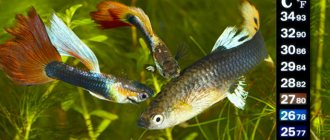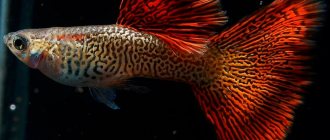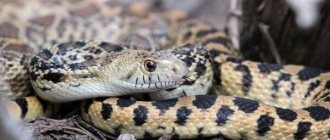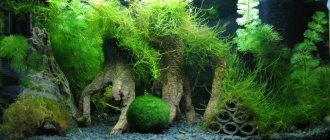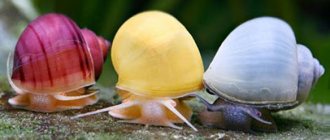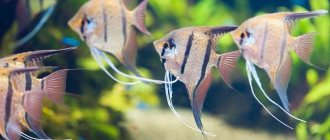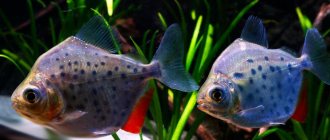Water and temperature requirements
The temperature in the aquarium affects not only the fish's environment, but also their biological and chemical processes. Therefore, it must be the same in all layers of water so that the creatures are not harmed.
For catfish, the optimal temperature is from 18° to 28°C. But, since this is an unpretentious fish, sometimes they can withstand small deviations from this norm. Water hardness for catfish is in the range of 8-12. The water must not be salty or seawater, otherwise the fish will die.
To maintain the temperature of the aquarium you should use:
- Special aquarium refrigerator.
- Air conditioning in the room.
- Ice or cold accumulator.
Description
Aquarium fish catfish are orderlies. They like to swim closer to the bottom of glass reservoirs, where it is darker than on the surface, and pick up food debris from stones and clean microorganisms and silt from them.
Both small and large representatives of the catfish family coexist in one aquarium. The size of giant catfish suitable for home breeding reaches 35 cm. This is exactly the length of the brocade pterygoplicht as an adult.
Most catfish are unpretentious eaters, but there are also predators, due to which fish often disappear. A very interesting representative of catfish is the sacbranch catfish. It is distinguished from other individuals by the presence of poisonous thorns, the injection of which is painful, although not fatal.
Popular types of aquarium catfish
Only a few species of aquarium catfish are found in home waters. The chain catfish family is popular among beginners and professionals.
They are distinguished by the presence of bone plates that cover the elongated body. Males are usually longer and brighter than females. In adult individuals, tentacles grow on the head - numerous outgrowths. In nutrition, chain catfish are unpretentious. Their diet consists of plants, but they will also happily eat bloodworms or fillets of sea fish.
Common types of aquarium catfish:
- Antennae or pimelod catfish. In nature, they live in rivers, so in captivity they require only filtered, oxygenated water. They do not have suckers, unlike most species of catfish, so they lead an active lifestyle. Antennas can be very small in size - up to 5 centimeters, but there are also real giants that grow up to 60 cm in length.
Catfish do not eat garbage and food waste, so you should not keep them only for these purposes. They also need care, special living conditions and quality food.
Do catfish need oxygen?
Catfish are also not demanding on the oxygen regime. They breathe through their skin, so they are able to inhale atmospheric air. In order for a catfish to inhale, it needs to swim to the surface, take in a portion of air and sink to the bottom to use up the collected air.
Be careful, if the catfish is on the surface for a long time, it means it simply does not have enough air. As an exception to an aquarium creature that does not breathe through its skin, Pangasius, the shark catfish, is considered.
Content
Caring for catfish in an aquarium will not cause much trouble for the owner. An important condition for the survival of these fish is timely feeding. If the reservoir is equipped with shelters, algae grows, and a comfortable temperature and water hardness are ensured, then caring for them is a pleasure.
What to feed catfish
Feeding catfish will also not cause much trouble for the owner. If there are other fish in the aquarium, there is no need to feed the catfish specially. They perfectly feed on the remains of food lying on the bottom, while simultaneously cleaning it, so you don’t have to specially feed them. Pieces of fish, shrimp and flakes sold in pet stores are ideal food for aquarium catfish. In addition, small neighbors in the aquarium can become food for predatory representatives. When choosing such species, you need to remember that catfish can eat small fish.
How long do catfish live?
The largest representatives living in nature can live up to 100 years, but domestic fish are not so long-lived. Depending on the type of catfish and the conditions of its keeping, the average lifespan of catfish is 8 years, provided that aquarium catfish live in suitable conditions.
Ground and shelters
There are also no special requirements or recommendations for the soil. The soil and shelters must be in the aquarium, since catfish are bottom dwellers. It could be anything: plants, decorative figures or some kind of driftwood, fish houses. If you have plants in an aquarium, pay attention to artificial options, as real catfish will quickly eat them.
If the fish have nowhere to hide and be alone, they will be in a state of stress, their appetite will worsen and its lifespan will be shortened.
Corydoras Pygmy maintenance and care breeding
Body structure of speckled catfish photo
All types of corydoras are relatives of the speckled catfish
Breeding and propagation of speckled catfish
As already mentioned, breeding speckled catfish is not difficult; in fact, it is one of the first fish that could be bred in an aquarium. It can even spawn in a community aquarium. The catfish lays eggs, but can eat them, which means separate aquariums are needed for spawning and for raising fry. For reproduction, a pair or three is needed: a female and two males. Some breeders recommend even more males per female. Producers should be fed with live food - bloodworms, brine shrimp, daphnia, tubifex. It is a protein-rich diet that serves as an incentive for the start of spawning. If it is impossible to get live ones, you can feed frozen ones.
In the photo, the sexual differences between the male and female speckled catfish Corydoras
The female, ready for spawning, will become noticeably thicker, and in general the fish will become more active. In the female, the belly may take on a reddish tint, and the first ray of the pectoral fin may also turn red. At this point, it is necessary to replace a large amount of water in the spawning tank (about 30%) with water at a lower temperature. Changing water with a temperature drop of 5 degrees imitates the rainy season in nature. And this serves as a trigger for the start of spawning. If spawning has not started within one or two days, repeat the process again. Spawning of speckled catfish is similar to how all corydoras spawn. First, the male stimulates the female with his antennae, tickling her on the back and sides. Then the male takes the traditional T-shaped pose for Corydoras. In which his body forms a right angle with respect to the female’s nose. At this moment he releases milk. To this day, there is debate about how the eggs of the speckled fish are fertilized. Some believe that the female swallows the milk, passes it through the intestines and releases it onto the eggs, which she holds in the ventral fins. Others believe that milk is released into the female’s mouth, and she, passing it through the gills, directs it along the body into the eggs. Once the egg is fertilized, the pair separates and the female glues the egg to a surface she has chosen and cleaned. It could be glass, a filter, plants. As soon as the eggs are laid, the male again begins to stimulate the female and the mating ritual is repeated. This continues until two or three hundred eggs have been fertilized and stuck in the aquarium. Spawning lasts an hour or a little more. Once the spawning is over, the parents should be removed from the aquarium, as they may eat the eggs. The eggs will mature in approximately 6 days, although the period depends on the temperature; the warmer the water, the faster. Cool water can extend the period to 8 days. As soon as the fry hatches, it can be fed with very fine food: cyclops, brine shrimp larva, microworm, or branded food ground into dust. It is important to keep the water clean with regular water changes.
Beautiful photo selection of speckled corydoras catfish
An interesting selection of videos of the speckled corydoras catfish
fanfishka.ru>
Do catfish clean the aquarium?
Surely, sellers in pet stores and friends who own aquarium catfish often told you that these fish clean the aquarium, so you don’t have to do anything additional. This is not entirely true. Catfish actually clean the aquarium, picking up leftover food, food waste or some kind of scales from the bottom. But, if the area of the aquarium is large enough, and there are very few fish, catfish simply will not cope with their task.
This way the fish will be cleaned up as best they can, but you will still have to do the basic cleaning to keep them from dying. It is necessary to purchase a water purification filter to help aquarium residents.
Compatibility and Behavior
Catfish are peace-loving, calm creatures, indifferent to neighbors of other species, but can start fights among themselves. It happens that a larger male chases a smaller one and tortures him to death, but such behavior is rare.
Compatibility with other species is determined by the species of the catfish. If the pet is quiet and a herbivore, then peaceful, non-aggressive fish are added to it. And for the proximity to the predator, they select large fish that do not show aggression, but do not allow themselves to be offended.
Breeding catfish
If you only have catfish in your aquarium, don't worry, you don't have to do anything. And if you have mixed fish, it is better to transplant the catfish into a separate container with clean water, preferably the volume is 30-40 liters.
Usually for one female it is enough to choose 3-5 males. It is necessary to provide their new place of residence with algae and soft soil.
To make the catfish feel comfortable and begin to mate, change the water every day for several days. The temperature should be 17-15°C. Saturate the water with oxygen more often. You can place the aquarium in a dark place or cover it with something, since catfish do not mate during the day. If you follow all the rules, you will see results in 5-7 days.
Aquarium catfish and catfish
About two thousand species of catfish inhabit the fresh waters of the world. These are one of the oldest fish on the planet, their fossil remains were discovered in sediments of the late Cretaceous period (70 million years ago).
One of the main signs is the absence of scales, often replaced by bone plates. Catfish lead a bottom nocturnal or twilight lifestyle. There are also predators among them, but most species prefer detritus, plant food and benthic invertebrates. Aquarists keep up to 800 species of catfish, not counting hybrid forms. Normal aquarium conditions are suitable for keeping: hardness 6-12°, temperature 22-26 °C. acidity is neutral, with slight deviations in one direction or another. Thanks to cutaneous respiration, or the ability to breathe atmospheric air, most catfish are not demanding of oxygen. Haplosternums, for example, swallow air, it enters the intestine and is absorbed into the blood through a dense network of capillaries.
Armored, or callichthid, catfish are represented by almost one and a half hundred species, common in the waters of South America. These are typically omnivorous bottom-dwelling fish. Their body is quite tall, triangular in cross section, covered with bone plates arranged in two parallel rows, reminiscent of parquet. The small lower mouth is surrounded by three pairs of antennae, which help in searching for food. Males are slimmer than females and have more developed dorsal and pectoral fins. Callichthids get along well with any fish, simply ignoring them completely. They themselves are unattractive prey even for large predators. In aquariums with armored catfish that constantly dig at the bottom, it is necessary to arrange efficient water filtration, cover the bottom with pebbles, and plant plants with a strong root system. The impetus for the spawning of callicht catfish is a drop in atmospheric pressure, the addition of soft, cooled water by five degrees and the presence of a substrate for laying eggs. The incubation period is 5-8 days at a temperature of 25 °C. The starting norms are rotifers, microworms, brine shrimp and mixed feed.
Of the armored catfishes, the most common genera among aquarists are Corydoras and Hoplosternum . The genus Corydoras includes the golden catfish (C. aeneus) and the speckled catfish (C. paleatus). The body of the Corydoras is short and ridged. The abdomen is flat, the back is convex. The male's dorsal fin is pointed. The main color of the speckled catfish is olive with a metallic sheen, the back is darker, and the belly is yellow-orange. Irregular dark spots are scattered throughout the body. The golden catfish has a wide shiny dark green stripe running along its entire body. In the anterior third above it there is a narrow golden one. The head and back are dark brown. Both species have albino forms. The speckled catfish is an old-timer in aquariums. Its first breeding dates back to 1878.
Hybrids of golden and speckled catfish are widespread in aquariums, as well as their hybrids with Corydoras Rabo, Schwartz and black-striped Bond. The fish grow up to 7 centimeters in length, females are larger than males. Vessels with a volume of at least 80 liters are suitable for spawning. The fish are placed in a spawning tank in a group, with a predominance of males. The water temperature is slightly above 20 °C. The composition does not play a role. The female lays her eggs in the pelvic fins folded together, where they are fertilized by the males, and glues them to a solid substrate. This could be a leaf of a plant or glass of an aquarium. If spawning took place in a community aquarium, the eggs can be carefully removed with a razor and transferred to a separate vessel for incubation. The best starter food is brine shrimp. In addition to those mentioned, at least three dozen more Corydoras can be found in aquariums. The genus Hoplosternum is much less rich in species. But one of them is perhaps the most famous aquarium catfish.
Thoracatum ( Hoplosternum thoracatum) from Eastern Brazil has been bred in Russia since 1910. This is a fish with a long round body, reaching 18 centimeters in length. The body is covered with two rows of plates, like the Corydoras. At the highest point of the back there is a rather large dorsal fin. The color of the catfish is brownish-brown, with irregular dark spots. There is a black color option. In males, the anterior ray of the pectoral fin is greatly thickened and turned into a powerful bony spine of orange-bloody color. Torakatums build foam nests under floating objects and plant leaves, releasing air bubbles not with their mouths, like labyrinths, but from under the gill covers. In the spawning area, the easiest way is to use a foam raft the size of a school notebook. During spawning, a female can spawn up to 1000 eggs. The male is left to guard the nest, but the raft with the eggs stuck to it can be transferred to a separate vessel. It is advisable to carry out prophylaxis against fungi and add methylene blue or trypaflavin to the water. Two days after hatching, the juveniles begin to take artemia.
The beige hoplosternum ( Hoplosternum litorale) is not inferior in size to the previous species. The color is beige-olive, sometimes gray with a greenish tint. The body is torpedo-shaped. These catfish build nests in the form of a large and high cap of foam mixed with scraps of plants. Both species of Hoplosternum are unpretentious, peaceful fish that love darkness. In aquariums, shelters made of driftwood and stones and shaded areas of the bottom are desirable. During maintenance, water parameters do not play a role. In spawning grounds, it is necessary to add soft water and raise the temperature to 24 °C.
The family of chain catfish is not deprived of the attention of either experienced aquarists or beginners. A distinctive feature of these bottom-dwelling fish is a strongly elongated or flattened body, completely covered with multifaceted bony plates, and a well-developed oral sucker with tubercles and outgrowths for scraping off algal formations. Males are larger, brighter and slimmer than females. In adulthood, they have numerous outgrowths on their heads that resemble plant roots - tentacles. In females they are much less pronounced. The main food of loricariid catfish is plant-based, but they do not refuse bloodworms, tubifex, fillets of sea fish and sinking feed. The eggs are deposited in ceramic or glass tubes. During the entire incubation period of the eggs, 6-10 days, the male sits in the tube, covering the eggs with his body. If spawning occurred in a common aquarium, the tube, along with the male and the eggs, is transferred to a separate container, simply closing the ends with your hands. When the fry swims, the male is removed, and the fry is fed with brine shrimp, mixed feed or algae paste.
Ancistrus (Ancistrus dolichopterus) - from the waters of Brazil. The flat body is painted in dark colors with light spots. The abdomen is light. The large dorsal fin resembles a flag. The fish grow in good conditions up to 14 cm. They swim ineptly and reluctantly. They spend most of their time clinging to the glass of the aquarium or plant leaves and scraping off algae. Activated in the dark and when atmospheric pressure drops. Ancistrus are quite suitable for the conditions of a community aquarium, to the other inhabitants of which they do not pay the slightest attention. The female lays 50-100 sticky, oblong, bright orange eggs that resemble small barberries. The water in the spawning tank and nursery aquarium needs to be slightly acidic, pH=6.0-6.5, temperature 26 °C. The fry begins to take food 6-8 days after hatching.
Loricaria (Rineloricaria sp. “Red”) is one of a large family of fish, most commonly known as “red loricaria.” The body is elongated, highly elongated, thin. The length of an adult fish reaches 12 cm. The color is red, of various shades. The male is slimmer and has a brush of bristles on his pectoral fins. Loricarias are absolutely peaceful fish. They lead a modest lifestyle, often hiding so that it is impossible to find them in the aquarium. They take any food from the bottom. Spawning is seasonal - in winter. It flows like ancistrus. Suitable tube diameter is about 30 mm. Swimming fry look like scraps of threads 7 mm long. They are very sensitive to water contamination with organic matter. In a nursery aquarium, a filter with activated carbon and a daily complete replacement of water with fresh water of the same composition and temperature are required. Settled tap water, passed through a filter, is suitable. The fry grows quickly and soon ceases to react painfully to pollution. When installing filters in aquariums with chain-linked catfish, and especially with their juveniles, it is necessary to prevent fish from getting into the structure. They tend to look for cracks and holes and crawl into them. Once caught in the filter, catfish usually die.
Sturisoma panamense is a catfish with a very thin and long body. The snout is sharp, the pectoral and dorsal fins are large, in the shape of a sharp triangle. It grows up to 30 cm, while being almost a complete vegetarian. He is picky about food - he needs algae tablets, lettuce, even cucumbers. Does not tolerate pollution. The eggs are laid in a tube.
Brocade pterygoplichthys (Pterygoplichthys gibbiceps) . Luxurious catfish from the river. Orinoco. Black or dark brown spots - brocade - are evenly scattered over the light body. The dorsal fin is large and high, sail-shaped. The mouth is a large, strong sucker. Swims poorly and reluctantly. It eats fouling and scrapes wood snags that need to be provided to it. But he doesn’t refuse bloodworms either. Water hardness varies widely, temperature from 23 to 30 °C. The "brocade catfish" has become very fashionable in recent years, but often becomes a problem for beginners. On sale there are usually juveniles measuring 5-7 cm. When purchasing a catfish, they often do not know that it can grow up to 30-35 cm. In a small aquarium, pterygoplicht becomes a “bull in a china shop”, and in a large aquarium, with slow large fish, for example discus fish, trying to attach to them. Catfish are probably attracted to the mucus that covers their body. As a result, the scales are damaged and ulcers may occur. Pterygoplichts does not pay attention to small fish. We can recommend catfish from the genus Hystomus, similar to Pterygoplichthas, which lack this disadvantage and do not grow so quickly.
Hypostomus has a body shape that strongly resembles Pterygoplichthas. The dorsal fin is smaller, the color is brown, reddish or reddish. Imported under the names Hypostomus sp., Hypostomus spotted, Hypostomus red, Hypostomus albino and Hypostomus watawata. The last name seems closest to the truth. The conditions of detention are no different from the brocade catfish. Watawata from Peru is the most useful inhabitant of the aquarium. A convinced vegetarian, not paying attention to bloodworms, is constantly busy cleaning the aquarium of algae. To perform ideal continuous cleaning in a two-hundred-liter container, one catfish is enough. In my pet store, there is always one Watawata catfish in each aquarium. If the catfish does not have enough pasture, it is necessary to feed it with plant food.
Armored catfish are covered with a durable bony shell, which is absent on the flat belly. Crepuscular, solitary fish looking for food at the bottom. The dorsal and pectoral fins are equipped with strong, jagged spines. Be careful: catfish easily get entangled in the net, and a pricked finger hurts for a long time. If you pick up a catfish in your hands, it makes a loud squeaking noise. Omnivores, but need at least a third of plant food. Withstands a wide range of water hardness, acidity and temperature. They are indifferent to the oxygen content in water and can swallow atmospheric air. Aquariums most often contain agamix (Agamyxis flavopictus) - black in color, with light spots, and platidor (Platydoras costatus), which has yellow stripes on its dark brown body - two on the sides and one on the ridge. Both fish have a short massive body and a large head with not very long whiskers. They grow up to 12-15 cm. They do not pay attention to their neighbors, busy with their own affairs. They require not too coarse gravel at the bottom and shelters made of ceramics or driftwood. The content is not complicated. Breeding is only available to experienced aquarists.
Killer whales are fast, sociable, diurnal catfish that stay in the water column. They are not very predatory and can be kept in a species aquarium with other fish. The skin is bare, without bony plates, the first ray of the dorsal fin is transformed into a hard spine. Water parameters can vary widely. Omnivorous, but live food is preferred. Males are smaller and slimmer.
The most popular killer whale is Mystus tengara . It would be more correct to call the catfish “tengara”, since several other mistuses are common, but the name has taken root in the aquarium hobby. The body is elongated, silver-gray, with a bluish tint and light longitudinal stripes. The eyes are large, with contrasting “earrings” behind the gill covers. The snout has four pairs of rather long antennae. Length up to 12 cm. Mistus is a “shock” fish. If there is a sudden change in conditions, for example during a transplant, he “faints” and may die. It doesn’t matter whether the new conditions are worse or better, the mystus reacts only to their change. Before planting newly acquired fish in the aquarium, you need to smoothly equalize the water parameters. The easiest way is to add water from the aquarium intended for it to the water in which the catfish arrived, using a thin tube.
The reddish killer whale ( Mystus micracantus) , similar in shape to the Mystus, but colored in pink-red tones, with large dark spots behind the gill covers and a dark band on the caudal peduncle, and the Siamese killer whale (Leiocassis siamensis), dark brown, with wide yellow transverse stripes, like a bumblebee, are kept less frequently. Caring for them is not difficult, breeding is not mastered.
Sinodontis is a genus of African catfish from the rivers Zaire, Nile, Niger, Zambezi and others. About 10-15 years ago they suddenly entered Russian aquarium fashion. Many of them are peaceful and calm fish, quite large in size. The body is torpedo-shaped, triangular in cross-section, with a large, wide head. Three pairs of long branched mustaches. The color is very variable - from ash-gray to almost black with dark and light spots. All types of synodonts are able to swim belly up, combing the surface of the water with fluffy mustaches and collecting insects that have fallen into the water. For the skinwalker (S. nigriventris), this method of swimming has become the main one. Keeping synodonts is not a problem. The water reaction is neutral, the temperature is 22-26 ° C, but it is advisable to increase the hardness to 18 °. Catfish become active at night, eating bloodworms and other food prepared in advance for them at the bottom. Reproduction of synodonts is very difficult. Only from one species (Synodontis spec.) is it possible to obtain offspring in the traditional way, and even then not always. The most common are: Angelic synodont, (S.angelicus) - black, with white polka dots. Contrary to its name, it attacks small fish and is only suitable for keeping with cichlids or other fish that can fend for themselves. Size up to 20 cm, usually no more than 15. Changeling (S. nigriventris) is a peaceful catfish up to 6 cm long. Suitable for any aquarium. The color is gray, with streaks, but recently a pure black color option has appeared. The cuckoo (S. multipunctatus) is not a bad companion in a community aquarium. The color is gray-yellow, with dark round spots. Drops its eggs on spawning African cichlids.
The sacbranch catfish (Heteropneustes fossilis) is the only species in the family. The body of this catfish is cylindrical, elongated, and the color is black-blue or brown. Sometimes with two golden longitudinal lines. There are also albinos. On the jaws there are 4 pairs of long, dark whiskers directed forward. Size up to 30 cm. Males are brighter and slimmer than females. During spawning, the coloration of the spawners intensifies and spots appear on the body. The catfish is attractive not because of its color, but because of its unusual shape. These catfish breathe atmospheric air. From the gill cavity to the tail itself, two air sacs extend, acting as lungs. In nature, this adaptation allows catfish to wait out drought, remaining almost without water in semi-dried mud. They can be kept in normal aquarium conditions. During the day, catfish prefer to hide in shelters under stones, snags or plant roots. They treat other inhabitants with indifference, but they can thoroughly scare away other fish trying to take their favorite place on the bottom. In order to avoid conflicts, it is better not to keep other bottom-dwelling species in an aquarium with them. The spawning ground requires sandy soil, onto which up to 5,000 eggs are laid after vigorous mating games. The fry swims on the seventh day, it is easily fed with compound feed and grows quickly.
Clarias angolensis (Clarias angolensis) . When young, it is very similar to the sacbranch catfish. The main difference is the dorsal fin, which extends almost along the entire body. The natural color is brown, with small specks. The marble form often goes on sale. The body is light yellow with dark brown large “marbled” spots. This is a voracious predator for a large species aquarium. It can grow as thick and as long as a teenager's arm. The content is very simple - almost any water parameters. Omnivorous and very voracious.
Pangasius (Pangasius hypophthalmus; syn. P. sutchii and P. sp.) . Catfish from Thailand are very popular in aquariums around the world. It has been imported to Russia not very long ago and is still little known among newcomers. The body is shark-shaped, bluish-silver, with a dark longitudinal stripe. The back is dark. A flock of pangasius rushes feverishly around the aquarium, adhering to the middle layers of water, greatly enlivening the underwater landscape. Quite a peaceful species, suitable for keeping with not too small species. He may panic and “faint,” but quickly comes to his senses. Gluttonous, grows quickly reaching 20 cm. Any food, temperature 23-27 “C, neutral water with slight deviations.
Glass catfish, or ghost catfish (Kryptopterus bicirrhis) . Active during the day, completely peaceful catfish with a transparent body. Internal organs and skeleton are visible through transparent muscles and skin. Lives in average aquarium conditions, but only in a flock. Single individuals die quickly. Keep only with peaceful neighbors such as small characins or livebearers. Easily catches infection from sick fish. At the same time, the transparent body of the catfish becomes cloudy. Thickets of plants are needed as shelters. A small regular water change is needed. Does not tolerate dirt well. It stays in the middle layers of water, swims slowly, “carefully”. Live and dry food is suitable. It grows no larger than 10 cm.
More interesting articles on the topic:
Fast-growing and long-stemmed plants
This group includes species important for the aquarium that receive nutrition directly from water and food.
How many fish can you put in an aquarium?
Well, the time has finally come to populate our aquarium with fish. Where did it start?
Echinodorus in the aquarium
Perennial marsh grasses from South America. The genus Echinodorus includes plants
Characin fish
Fishes belonging to the suborder Characinidae or Charcoidae are considered by many to be pearls
Introduction to aquarium keeping
I have been in the aquarium business for over forty years. And in 1987 he discovered, as far as I know
Turbellaria (ciliary worms) - parasites of aquarium fish
Causes: Triciadida can cause damage in aquariums primarily &
Reproduction
You can stimulate the reproduction of catfish by lowering the water temperature in the aquarium. The spawning period lasts up to 5 days, and during this time the female and several males must be transplanted into a spawning tank - a special container with a volume of 30 to 70 liters. You can also breed fish in a plastic basin if there is no other free container. It is advisable to additionally equip it with driftwood and plants so that the fish feel comfortable. The suitable water temperature for breeding catfish is 18–20 °C.
The main thing is to correctly determine the sex of the fish. It is usually not difficult to distinguish a female from a male; the male has a brighter color and a slender body. Changes in water temperature accelerate the onset of spawning. Courtship lasts about 1 week, while the male tries to show himself in all his glory. He circles around the lady, trying to arouse her interest. When the female pays attention to him, the male touches her with his antennae, indicating his readiness to reproduce.
Description of the breed, types, lifespan, differences between females and males
A characteristic feature of armored catfish is their lack of scales on the body; they are often replaced by bony armored growths.
The lifespan of these animals is quite long and ranges from 5 to 15 years.
Speckled catfish are peace-loving fish that do not pose a danger to other inhabitants of the reservoir. The maximum size of a fish of this species can far exceed 10 cm, the female grows up to 13-15 cm in length, and the male is much smaller, its size rarely reaches more than 5-7 cm. The difference between individuals of the opposite sex lies not only in size, but also in an excellent distinguishing feature is the size and characteristics of the upper dorsal fin: in females it is short and round in shape, and in the male it is elongated and pointed.
In addition to speckled catfish, there are many more species in the Corydoros genus, among which such catfish have been recorded: golden, shterba, trilineatus, Julia corydoras and many others.
Species features
Aquarium catfish are amazing fish that are orderlies and cleaners of aquariums . They are represented by numerous species that vary in weight and size, with some species reaching more than 300 kilograms in weight. At the same time, there are tiny species of catfish, about 2 cm long.
Other fish can also become residents of your aquarium: zebrafish, platie, barbs, swordtail, goldfish, mollies, parrot fish, veil tail, clown fish, cockerel fish.
Some nocturnal subspecies have electrical organs. Most species are omnivores, but there are also predators. Poisonous catfish are also quite common; their injection is painful, but not fatal to humans. Many species prefer a nocturnal, secretive lifestyle, so you need to wait until evening to admire them.
Did you know? The length of the catfish can reach 5 m and weight - 400 kg.
Fighting possible diseases
The main cause of diseases in catfish is their poor maintenance. Diseases can also be introduced through plants, other fish, snails or live food.
If the cause of the disease is poor maintenance, this can be easily and quickly corrected. To do this you need:
- Replace water more often.
- Improve living conditions, make them more suitable for catfish.
If the cause of the disease is different, then special medications must be used.
Important! It is very important to remember that aquarium catfish cannot tolerate treatment with salt and preparations that contain copper.
There are many drugs that contain table salt or copper sulfate. If you are still going to use these medications, it is better to reduce the dosage. But it is better to use other medications that are safer for these fish.
There are cases when the catfish suddenly changes color - it turns pale or light spots appear. This is a reaction to stress. After some time, when the fish calms down, the color is restored.
If catfish have problems with digestion, it is recommended to put driftwood in the aquarium . Otherwise, treatment of catfish living in captivity occurs in the same way as other fish.
Ancistrus
Ancistrus photo
Ancistrus vulgaris
Please note that if you are just planning to purchase these wonderful fish, be sure to watch who you buy and be careful. Often, and this is not an isolated case, newbies in the store are sold young pterygoplichths or plecostomus instead of ancistrus.
What a surprise it is for a beginner when, a year later, instead of a 10 (ten) centimeter catfish, a whole flame grows in his aquarium - 40 forty centimeters long, which, in addition to everything, craps like a Nile crocodile
The saddest thing is that no one will take this log back and you won’t give it back to good hands. In this connection, as a rule, the fate of such foundlings is very sad. They either become pulled down by rickets. Or they are released into nearby bodies of water, where they also quickly die.
But let's not talk about sad things. Let's focus on the content of ancistrus. It is very important that the aquarium with ancistrus has natural woody driftwood. These fish are phytophages and cellulose is extremely necessary for them. They are ready to gnaw on good fresh driftwood around the clock, like dogs on sugar bones.

